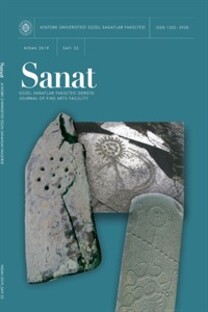Kastamonu Beldesinde, 879 (1474) Tarihinde, Hoşkademoğlu Ali Tarafından İstinsah Edilip, Tezhiplenen Bir Kur'an-ı Kerim
A Koran Copied and Illuminated by Ali, the Son of Hoşkadem, in Kastamonu in 879 (1474)
___
Arberry, A.]., The Koran Illuminated A Handlist of Korans In the Chester Beatty Library, Dublin, 1967.Gölpınarlı, A., Mevlânâ Müzesi Müzelik Yazma Kitaplar Katalogu, Ankara, 2003, s.17-18.
İbn-i Bibi, El-Evamlrü'l-Ala'iye Fi'l-Umuri'l-Ala'iye (Selçukname) I-II (Çeviren: Mürsel Öztürk), Ankara, 1996.
Karatay, F.E., Topkapı Sarayı Müzesi Kütüphanesi Arapça Yazmalar Katalogu, C.Ill, İstanbul, 1966.
Sümer, F., Selçuklular Devrinde Doğu Anadolu'da Türk Beylikleri, Ankara, 1990.
Uzunçarşılı, İ. H., Anadolu Beylikleri ve Akkoyunlu, Karakoyunlu Devletleri, Ankara, 1988.
Algaç, Ş., "Niğde'li Muhammed Bin Kutluğ'un 791 (1389) Tarihinde İstinsah Edip Tezhiplediği Mesnevi",Atatürk Üniversitesi Güzel SanaTlar Fakültesi Sanat Dergisi 3, Erzurum, 2003, s.143-148.
Blochet, E., "Inventaire et description des miniatures et manuscrits conserves â la Bibliotheque Nationel", Revue des Bibliotheque, Paris, 1985.
Çağman, F., "Sultan Mehmet II. Dönemine Ait Bir Minyatürlü Yazma: Külliyat-ı Katibi", Sanat Tarihi Yıllığı VI,1974-75, s.333-346.
Çetin, N. M., "Matnawi'nin Konya Kütüphanelerindeki Eski Yazmaları", Şarkiyat Mecmuası IV, İstanbul, 1961,s.98-117.
Tanındı, Z., "1278 Tarihli En Eski Mesnevi'nin Tezhipleri", T. iş Bankası Kültür ve Sanat 8, Ankara, 1990, s.17-22.
Tanındı, Z., "Tezhip Sanatı", Başlangıcından Bugüne Türk Sanatı, Ankara, 1993, s.398-406.
Ünver, A.S., "Selçuklular Zamanında Kütüphaneler Üzerine Yeni Örnekler ve Bazı Mülahazalar", III. Türk Tarih Kongresi, Ankara, 1948, s.642-646
- ISSN: 1302-2938
- Yayın Aralığı: 2
- Başlangıç: 1999
- Yayıncı: Cordus
Anne-Kız İlişkisi Temasının Sahne Tasarımına Yansıması
A. Didem USLU, Özlem ALİYAZICIOĞLU
Alanya Kalesinde Üç Bizans Kilisesi
Egzistansiyalist (Varoluşçu) Tiyatro
I. Petro Döneminin Sonuna Kadar Rusya'da Dansın Tarihsel Geçmişi ve Gelişimi
Azerbaycan Tapestry Sanatının Gelişme Süreci
Valide PAŞAYEVA, Ümmülbanu HAMİDOVA
Harold Pinter'in the Room (Oda) Oyununda Korku ve Barınak İlişkisi
